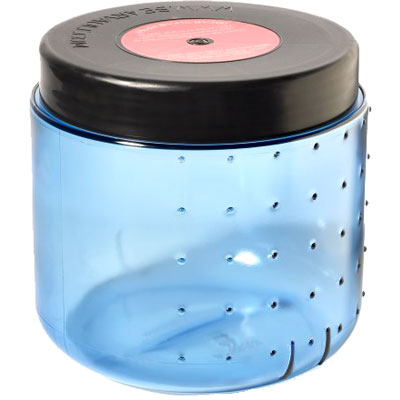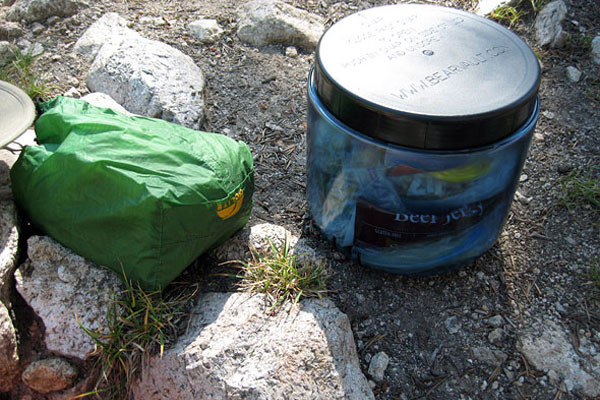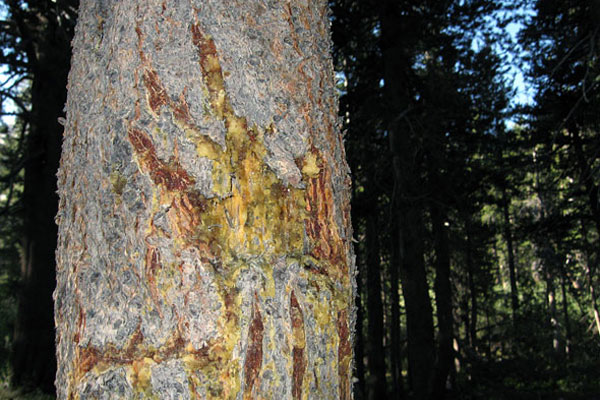Bearvault BV450 Solo

- peace of mind
- redesigned lid
- often mandatory
- 2lbs 1.5oz
Bearvault's BV450 Solo replaces all previous Solo models (BV200, 250, & 350), with the primary update involving a redesigned lid for better security and ease of use.
As far as bear canisters go, you can call me a reformed skeptic. The bottom line is they work. Additionally, I've found a few unexpected benefits to having a bear can along for the ride that almost (but not quite) negate the annoyance of their added bulk and weight. But first, some of you may be asking: just what the heck is this bear can thingy now required by law in many parts of my beloved High Sierra?


Bear canisters are an attempt to deal with human-bear encounters in the wilderness—which usually end poorly for all parties involved.
The typical scenario goes like this: humans concoct crafty hanging systems to keep their food away from bears. Bears subsequently demonstrate even craftier ability to defeat such efforts, eat human food, and keep coming back for more until the Forest Service is eventually forced to kill them.
Bearvault canisters are designed to de-habituate bears by preventing them from gaining access to your food.
Even if the bear smells the food, if he or she can't eat it, the bear will eventually give up and return to its native diet. Certainly, there was cause for skepticism about this somewhat rosy plan, but in practice it has panned out: bear canisters are reducing negative human-bear contact in the wild. Consequently, use of bear canisters is now mandatory for overnight hikers in many areas, such as the Mount Whitney Trail, the John Muir Trail, and of course Yosemite Valley.
Veteran hikers (and especially minimalists) may grumble about this regulatory intrusion, but in practice I've found that the peace of mind of using a bear canister is significant. You sleep better. You don't wake with every rustling sound wondering if a bear is feasting on your provisions. Another big perk is ease of use. It can be extremely challenging to find a tree suitable for hanging food.
Counter-balancing takes time and energy to set up, time to hang and retrieve food, and often fails anyhow. Of course, there are negatives as well. Bear Canisters are indisputably heavy. The BearVault Solo remains one of the lightest bear cans available, but you are still putting an extra two pounds of otherwise useless weight on your back.
Speaking of changes, the body of the Bearvault Solo remains the same: clear polycarbonate plastic. The lid, however, features not one but two locking tabs now, plus two textured areas and a sticker that make getting in and out of the can easier (for humans!). Note that the latching system on earlier 200/250-series models of the Bearvault did fail occasionally. These discontinued models are no longer approved for use.
Wondering whether to get the Solo Bearvault or the full-size canister? If you're a solo traveler, you may enjoy the slightly lower weight of the Solo. The BV Solo is also easier to fit into smallish (45 liter) packs. Note however that the full-size Bearvault offers a much better volume to weight ratio. If you travel in pairs, it is more efficient to get one large can and split it rather than carry two smaller cans.
If you're used to carrying overnight loads in 45-55 liter packs, trying to fit a voluminous canister inside your pack can prove frustrating. Still, in many wilderness areas today, you don't have a choice today regarding Bear Canisters. Carry them when you hike or risk a hefty fine. So, bite the bullet and get one. For their low weight, low price, toolless opening and closure, and strap-on capability, I recommend the BearVault. It's what I use.
 Smith Parallel
Smith Parallel North Face Base Camp
North Face Base Camp GoPro HD Hero2
GoPro HD Hero2 BearVault Solo
BearVault Solo Black Diamond Ion
Black Diamond Ion National Geographic Topo!
National Geographic Topo!